Sept. 23, 1952: Marciano vs Walcott I
After a record breaking reign atop the big man division, the great Joe Louis finally retired in 1948, and in the years immediately following, boxing struggled to find someone to be that larger-than-life figure that is a dominant heavyweight champion of the world. It would take an extraordinary fight, and a legendary knockout, to help boxing’s premier weight class regain coherence.
Before relinquishing his crown, Louis had faced veteran Jersey Joe Walcott twice. Their first clash in 1947 was one of the most controversial in history as the judges gave “The Brown Bomber” a narrow points win when everyone else saw Walcott the clear winner. The aging champion’s mortality was clearly showing and when he announced his retirement —after scoring an eleventh round knockout of Walcott in their rematch— all agreed it was the right decision. But shortly thereafter Louis was faced with a huge bill from the IRS for overdue taxes and the man who had donated hundreds of thousands to help the nation during World War II had little choice but to lace up the gloves again.
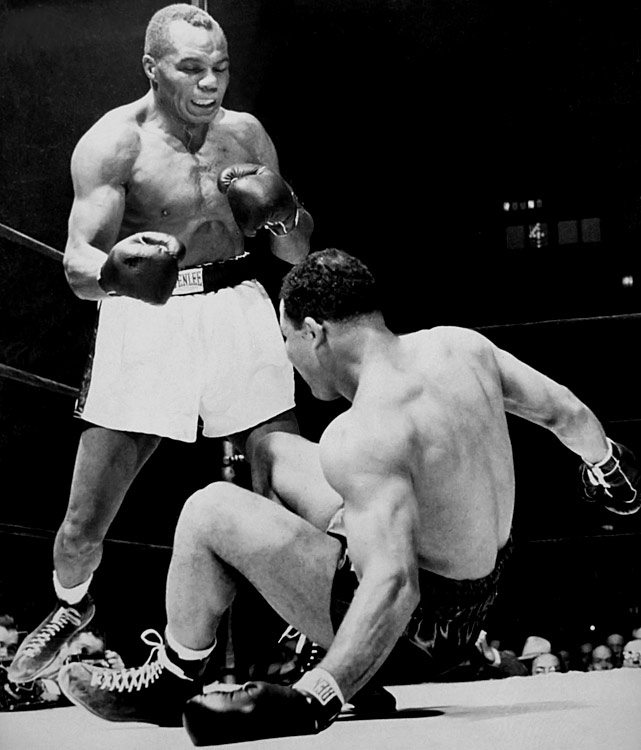
Meanwhile, Ezzard Charles had emerged as the new heavyweight king with a points win over Walcott in Chicago. He then turned back the challenge of the come-backing Louis and went on to defend the title against ranked contenders such as Nick Barone and Lee Oma. Louis continued to campaign, hoping for another shot and another much-needed big payday, but in October of 1951 he ran into a burly young slugger from Brockton, Massachusetts named Rocky Marciano. The two contenders battled in Madison Square Garden and nostalgic fans of “The Brown Bomber” fought back tears after Louis was knocked out by the younger, stronger man in round eight.
Rocky himself was less than euphoric over his win. “Imagine looking at Joe Louis lying there on the ropes,” he remarked afterwards. “And I did it. I don’t know if I’m happy about it.”
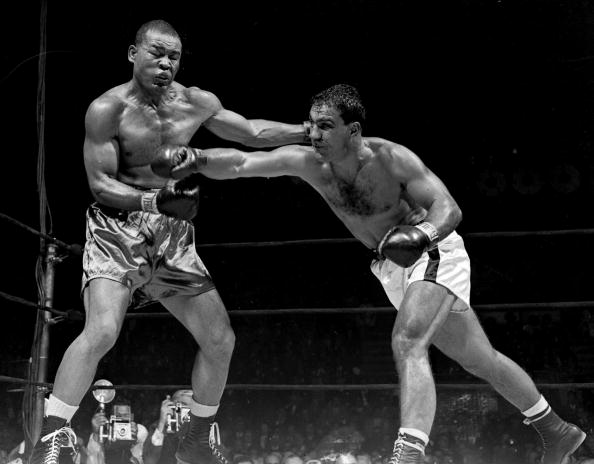
Meanwhile, earlier that same year Charles and Walcott had fought twice more, the rematch in Detroit yielding another decision win for “The Cincinnati Cobra,” but more than a few thought the verdict represented a second championship robbery inflicted upon Jersey Joe. So, Ezzard and Walcott made it a trilogy, this time in Pittsburgh, and this time old Jersey Joe scored a most historic win. With a lightning left hook in round seven he became the oldest heavyweight champion in boxing history.

The following June, Walcott beat Charles again, this time on points, while Marciano had scored four straight knockout wins to firmly establish himself as the division’s top contender. The stage was set: all could see that the two best heavyweights in the world were Jersey Joe and “The Rock,” and thus their battle for the championship drew some fifty thousand to Philadelphia’s Municipal Stadium, while also being beamed to a record fifty theaters in major cities across America.
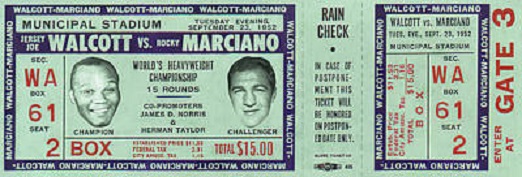
Marciano vs Walcott inspired great public interest in part because opinions on who was more likely to win were sharply divided. For most, Marciano’s advantages in youth and power were too much for a ring-worn, 38-year-old veteran to overcome. But more than a few saw Walcott’s edge in experience, ring-smarts and technique as being the deciding factors. Jersey Joe was too old and used up, said some; Rocky was too callow and crude, said others.
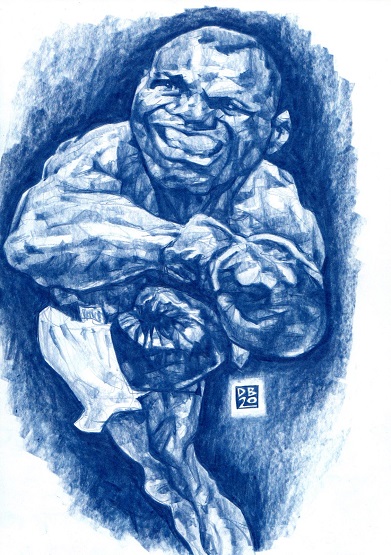
For his part, Walcott dismissed Marciano as any kind of threat, telling all who would listen how this young kid just did not have the ability to give him a tough battle, let alone defeat him. To the veteran’s eyes, Rocky was an inexperienced and unschooled brawler, lacking in finesse and technique. “Write this down,” he growled to reporters. “He can’t fight. If I don’t lick him, take my name out of the record books.”
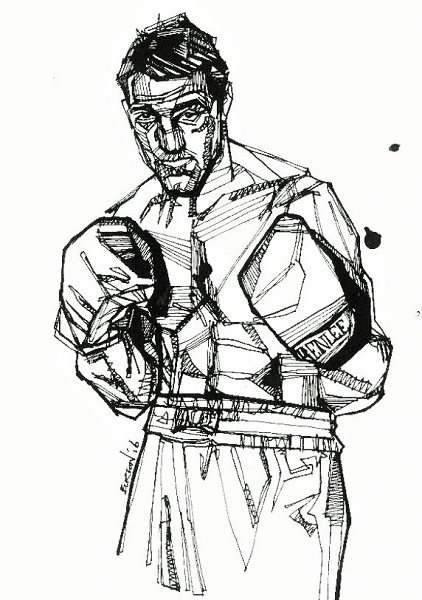
And for the better part of twelve rounds, Walcott and his backers were proved correct. Midway through the opener Jersey Joe stunned the challenger, not to mention the huge crowd, when he snapped home a sharp left hook that gave Marciano the first knockdown of his career. Rocky was up at the count of four, but he was clearly hurt and he took a beating for the rest of the round. Indeed, Walcott, like the skilled and experienced workman that he was, utilized his superior technique and skill to dominate the early going, turning back Rocky’s charges with ease and testing his chin repeatedly, in the process making liars out of those who had dismissed him as too used up to compete with the younger man.
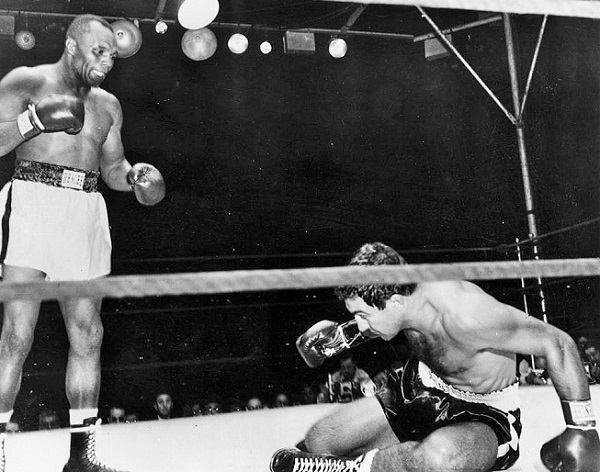
But the challenger started to find his rhythm in round four, bulling his way inside to launch his own offensive. It had already been a fast-paced and bruising battle, but the struggle only intensified as, through sheer brute strength and aggression, Rocky forced Walcott’s back to the ropes. There, one ferocious exchange followed another, both taking turns throwing and eating leather at a furious pace, and in the sixth the violent warfare led to an inevitable clash of heads: the challenger suffered a cut on his scalp, the champion a slice over his left eye.
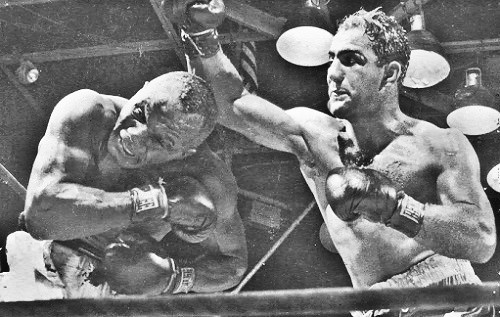
Of course both corners then applied solutions and coagulants to treat the wounds and at the end of round seven Rocky walked back to his corner declaring that he couldn’t see. Something had gotten into his eyes and for the next three rounds Marciano fought with impaired vision. Jersey Joe didn’t need to be asked twice. He took full advantage of his now vulnerable challenger, easily avoiding most of the challenger’s forays and then countering with precision, landing big shots again and again, opening up more cuts on Marciano’s face and raising swelling around Rocky’s left eye.
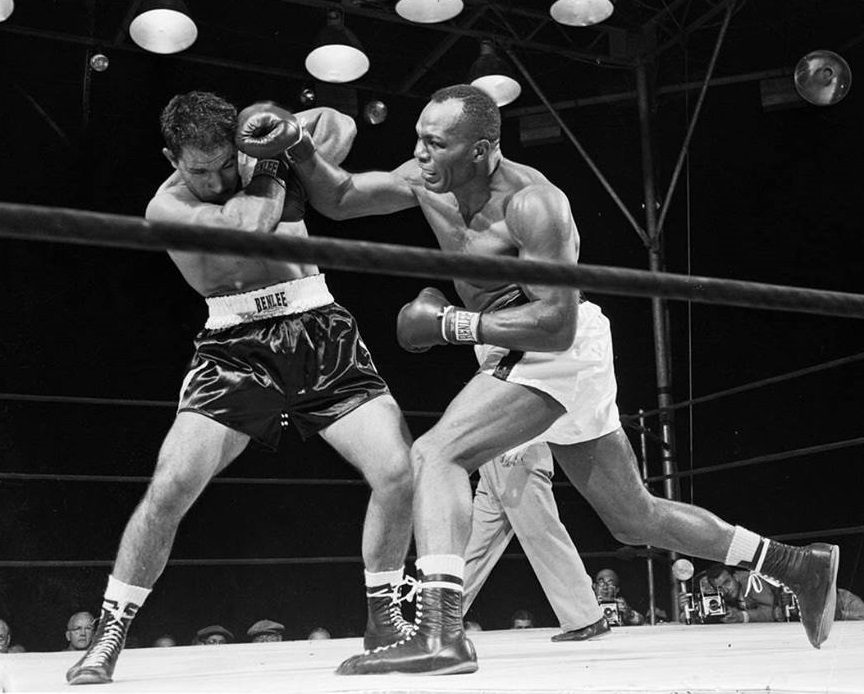
It was proving a most impressive performance: the wizened, 38-year-old, a veteran of so many battles with so many great battlers, one of the very few to defeat the legendary Joe Louis only to be denied by the judges, was doing all he said he would and out-dueling the younger, stronger man with authority. After twelve bruising, fast-paced rounds he was clearly in command, so far ahead on points that Rocky needed a knockout to win. Experience, skill and ring intelligence were proving too much for raw power and youthful exuberance as Rocky, while inflicting his share of punishment, increasingly appeared out of his depth.
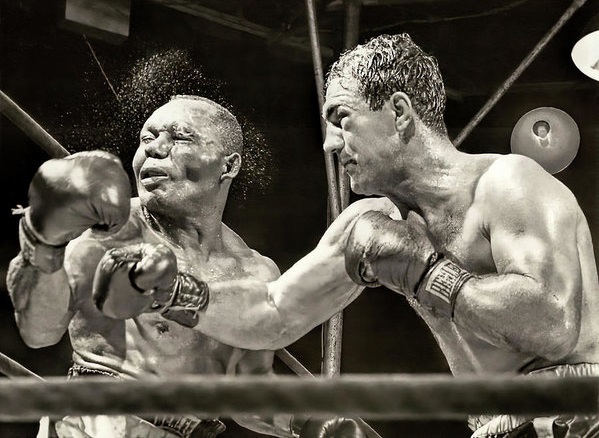
And then it all came to a crashing end. Marciano answered the bell for round thirteen with malice in his heart, intent on turning the tide and finally imposing his will. He stalked the champion from a crouch, forcing him to retreat, while brandishing his left hook, compelling Jersey Joe to be on guard for it. But when Walcott’s back touched the ropes, both men unleashed big right hands. It was akin to the stereotypical gunslinger duels from the old western movies, the two cowboys drawing their guns in the dusty street, each man firing a single killer shot.
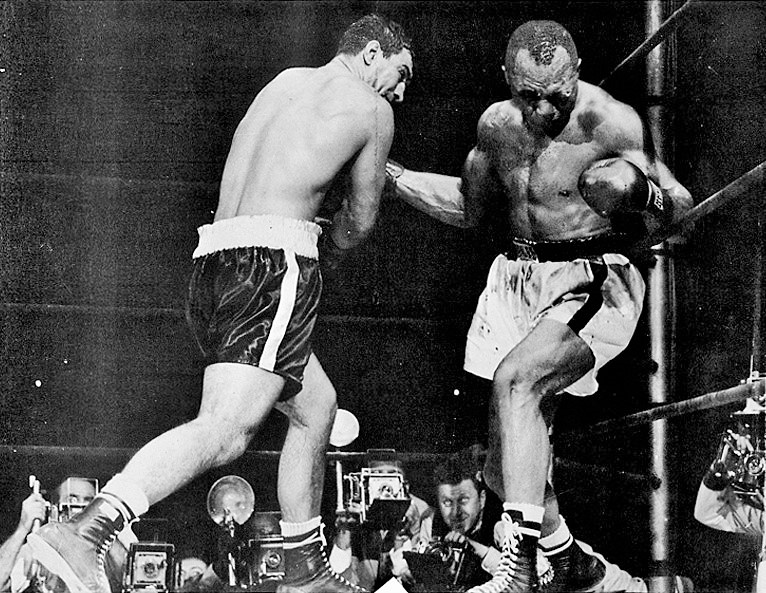
And Marciano was the quicker draw as Walcott, anticipating the left hook, never saw the right coming, a perfectly timed shot that barely traveled ten inches. The punch was the equivalent of a circuit breaker, landing flush on Jersey Joe’s chin and instantly turning off the lights. An unconscious Walcott collapsed in sections into the ropes, his left arm, hooked over the middle strand, suspending him as Marciano landed a gratuitous left. The referee then pointlessly tolled the ten count as Jersey Joe’s insensate body slowly surrendered to gravity and came to rest on the canvas; he could have counted to a thousand if he’d wanted.
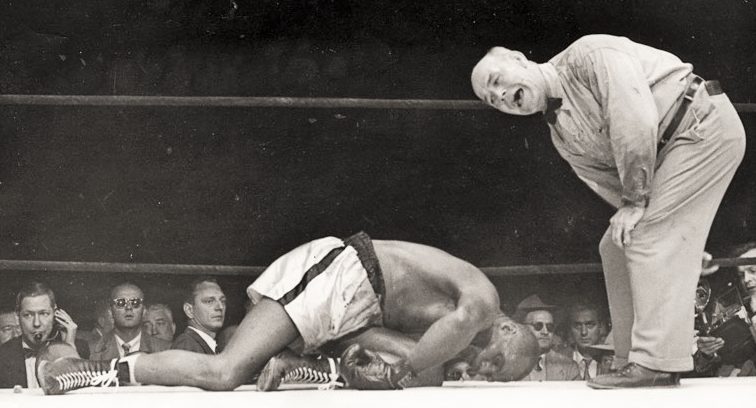
That short, vicious right hand will forever be one of the most consequential punches ever thrown in a prize ring. A single blow not only erased Walcott’s lead on the scorecards, but also marked the beginning of a new chapter in the history of the heavyweight championship and the end of Jersey Joe’s Cinderella career.
Marciano vs Walcott II took place eight months later and those hoping for another dramatic and action-packed battle were left completely disappointed. Walcott was knocked out in the opening round, the defeat demonstrating that a single right hand had destroyed Jersey Joe’s confidence and finished him as a boxer. Rocky went on to rule the heavyweights for the next three years, imposing order on the chaos that had ensued after the retirement of “The Brown Bomber.” And years later, when asked about the toughest battles in his career, Marciano would point to that first brutal slugfest with Walcott as a grueling test he was grateful to have passed. — Michael Carbert



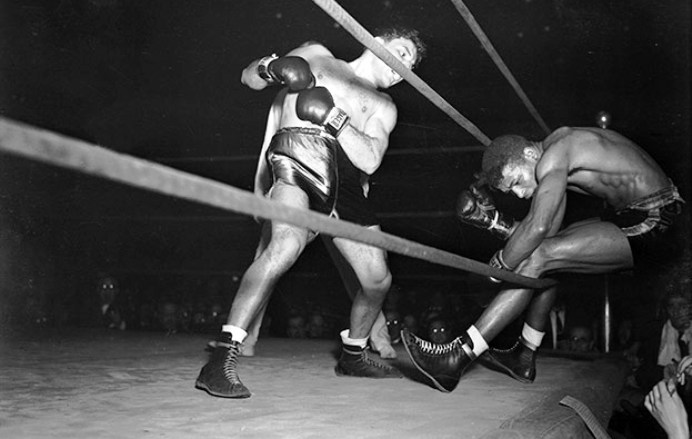
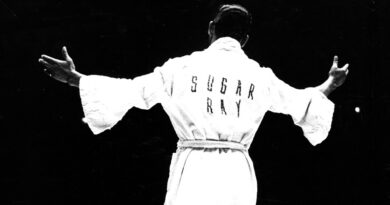
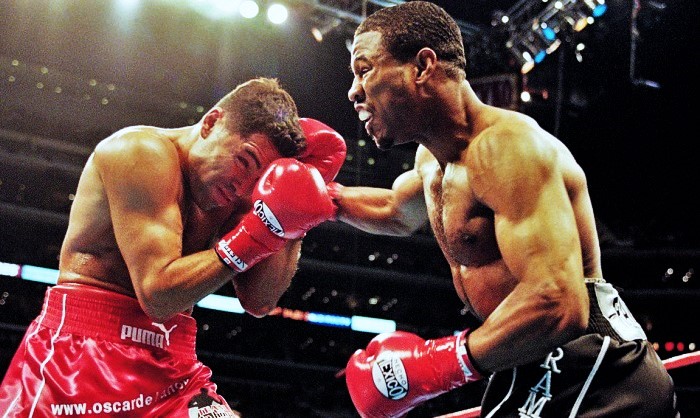
Great article. What makes Rocky a wildcard in any fantasy match-up is the fact he can deliver an elite-level haymaker at any moment of a 15 round fight. Walcott fought a hell of a fight, and was doing everything right in spoiling Rocky’s style, but Marciano was too persistent. Love the photos!
On September 23, 1952 a buddy of mine and myself were walking down Broad Street and I said, “Something’s going on there, let’s find out, Micky.” What was going on was Rocky Marcioano vs Jersey Joe Walcott and we found an unlocked gate and an empty seat and we saw the whole fight, a real battle until the end. There was blood spraying all over. What a knockout.
Rocky Marciano was a machine. No steroids, just the fittest heavyweight to ever enter a ring. Look at his forearms; look at his legs. He wasn’t as small as most think. No one had the engine that Rocky had and no one had that Suzie Q. Who else could take the punishment he did and then come back to win? The best ever, along with Joe Louis and Jack Johnson.
That has to be the most immortal right hand thrown in the history of prize fighting. There isn’t a boxer who lived that could’ve survived that. They don’t make them like “The Rock” anymore.
Rocky was the consummate gentleman and a kind hearted soul with the heart of a raging bull. In the ring, he could throw an over hand right or left uppercut that would blow your head off. After this bout, JJW was never the same. He took a painful beating from Rocky. Walcott did everything possible to win, but in the end, he didn’t
Rocky was savage in the ring and a gentleman outside of it. His record speaks for itself. Undefeated with knockouts in 43 of 49 fights. All who fought him were never the same afterwards.
In one of the post-fight magazines, under a two-page photo of Marciano landing that nuclear-like right, the caption said: “One punch made three scorecards meaningless.” Absolutely, and succinctly, a perfect description.
i liked your essay and the history you told about this awesome fight but why did you forget to mention that Rocky hit him while he was down, why didn’t the commentators asked Rocky why did he hit him while he was down? Was Joe knocked out by that hook, or was was he knocked out by that illegal punch that deserved to be a disqualifier? Why isn’t anyone in the comments saying anything about this injustice??
Both of Walcott’s knees (and hands) were above ground during that second punch, so it wasn’t an illegal punch.
People might compare Ingemar Johansson’s single right that started a seven-knockdown sequence the night he won the title against Floyd Patterson, June 26, 1959, with Marciano’s right described here. But the truth is, there is no real comparison. Patterson rose seven times…and was starting to rise yet again, when referee Ruby Goldstein stopped the fight. But one shot from Marciano put Walcott completely out. That’s the true test of power: KEEPING a man down. Foreman, for all of his power, couldn’t keep Frazier down despite six knockdowns over a round-plus in their first fight. Marciano also took out Rex Layne with a single right in the sixth round of their Jul 12, 1951, fight.
I don’t think it mattered all that much, Walcott was finished. Jersey Joe was a good fighter, ahead in the fight until that 13th round fight handed punch from the Rock…… then it was over. The borderline late hit wasn’t really a factor.